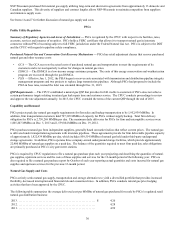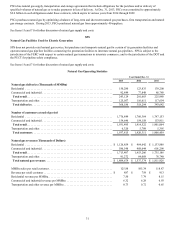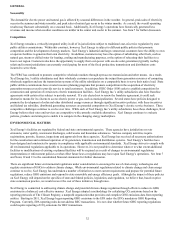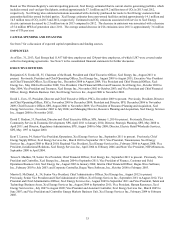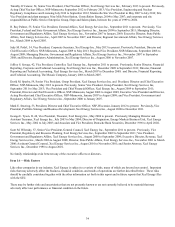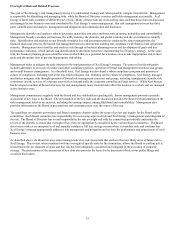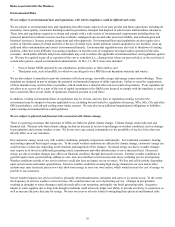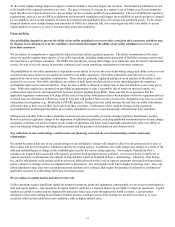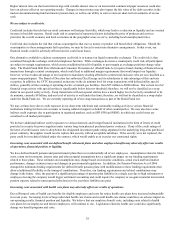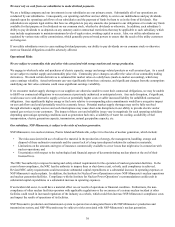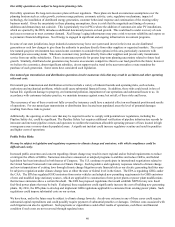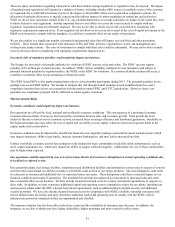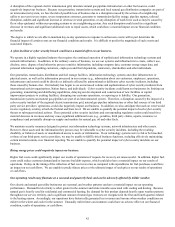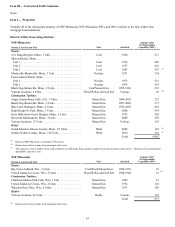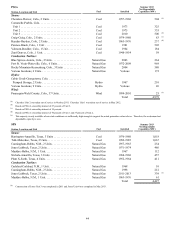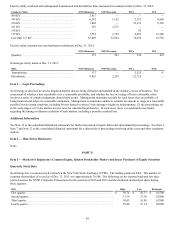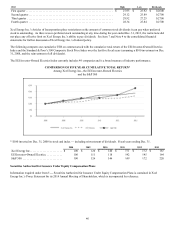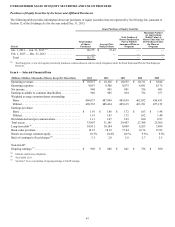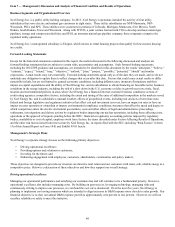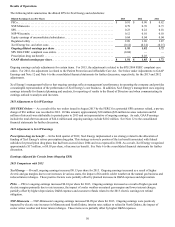Xcel Energy 2013 Annual Report Download - page 58
Download and view the complete annual report
Please find page 58 of the 2013 Xcel Energy annual report below. You can navigate through the pages in the report by either clicking on the pages listed below, or by using the keyword search tool below to find specific information within the annual report.40
Our utility operations are subject to long-term planning risks.
Our utility operations file long-term resource plans with our regulators. These plans are based on numerous assumptions over the
planning horizon such as: sales growth, customer usage patterns, economic activity, costs, regulatory mechanisms, impact of
technology, the installation of distributed energy generation, customer behavioral response and continuation of the existing utility
business model. Given the uncertainty in these planning assumptions, there is a risk that the magnitude and timing of resource
additions and demand may not coincide. This is particularly true in PSCo where the addition of customer-site solar PV installations,
which are spurred by the RES, introduces additional downward pressure on load growth. This could lead to under recovery of costs
and excess resources to meet customer demand. Xcel Energy’s aging infrastructure may pose a risk to system reliability and expose us
to premature financial obligations. Xcel Energy is engaged in significant and ongoing infrastructure investment programs.
In some of our state jurisdictions, large industrial customers may leave our system and invest in their own on-site distributed
generation or seek law changes to give them the authority to purchase directly from other suppliers or organized markets. The recent
low natural gas price environment has caused some customers to consider their options in this area, particularly customers with
industrial processes using steam. Wholesale customers may purchase directly from other suppliers and procure only transmission
service from our utility subsidiaries. These circumstances provide for greater long-term planning uncertainty related to future load
growth. Similarly, distributed solar generation may become an economic competitive threat to our load growth in the future; however
we believe the economics, absent significant subsidies, do not support such a trend in the near term unless a state mandates the
purchase of such generation. Some states have considered such legislation.
Our natural gas transmission and distribution operations involve numerous risks that may result in accidents and other operating
risks and costs.
Our natural gas transmission and distribution activities include a variety of inherent hazards and operating risks, such as leaks,
explosions and mechanical problems, which could cause substantial financial losses. In addition, these risks could result in loss of
human life, significant damage to property, environmental pollution, impairment of our operations and substantial losses to us. In
accordance with customary industry practice, we maintain insurance against some, but not all, of these risks and losses.
The occurrence of any of these events not fully covered by insurance could have a material effect on our financial position and results
of operations. For our natural gas transmission or distribution lines located near populated areas the level of potential damages
resulting from these risks is greater.
Additionally, the operating or other costs that may be required in order to comply with potential new regulations, including the
Pipeline Safety Act, could be significant. The Pipeline Safety Act requires additional verification of pipeline infrastructure records by
intrastate and interstate pipeline owners and operators to confirm the maximum allowable operating pressure of lines located in high
consequence areas or more-densely populated areas. A significant incident could increase regulatory scrutiny and result in penalties
and higher costs of operations.
Public Policy Risks
We may be subject to legislative and regulatory responses to climate change and emissions, with which compliance could be
difficult and costly.
Increased public awareness and concern regarding climate change may result in more regional and/or federal requirements to reduce
or mitigate the effects of GHGs. Numerous states have announced or adopted programs to stabilize and reduce GHGs, and federal
legislation has been introduced in both houses of Congress. The U.S. continues to participate in international negotiations related to
the United Nations Framework Convention on Climate Change. Such legislative and regulatory responses related to climate change
and new interpretations of existing laws through climate change litigation create financial risk as our electric generating facilities may
be subject to regulation under climate change laws at either the state or federal level in the future. The EPA is regulating GHGs under
the CAA. The EPA has regulated GHG emissions from motor vehicles and adopted new permitting requirements for GHG emissions
of new and modified large stationary sources, which are applicable to construction of new power plants or power plant modifications
that increase emissions above a certain threshold. The EPA has proposed regulations that would establish NSPS for any new fossil
fuel-fired power plants that may be built. If adopted, these regulations could significantly increase the cost of building new generating
plants. By 2016, the EPA plans to develop and implement GHG regulations applicable to emissions from existing power plants. Such
regulations could impose substantial costs on our system.
We have been, and in the future may be subject to climate change lawsuits. An adverse outcome in any of these cases could require
substantial capital expenditures and could possibly require payment of substantial penalties or damages. Defense costs associated with
such litigation can also be significant. Such payments or expenditures could affect results of operations, cash flows and financial
condition if such costs are not recovered through regulated rates.


